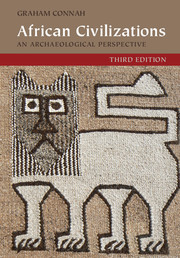Book contents
- Frontmatter
- Dedication
- Contents
- List of figures
- Preface and acknowledgements
- 1 The context
- 2 Origins: social change on the lower Nile
- 3 The Mediterranean frontier: North Africa
- 4 Sudanic genesis: Nubia
- 5 Isolation: the Ethiopian and Eritrean Highlands
- 6 Opportunity and constraint: the West African savanna
- 7 Achieving power: the West African forest and its fringes
- 8 Indian Ocean networks: the East African coast and islands
- 9 Cattle, ivory, and gold: social complexity in Zambezia
- 10 Central Africa: the Upemba Depression, Interlacustrine Region, and Far West
- 11 Settlement growth and emerging polities: South Africa
- 12 What are the common denominators?
- References
- Index
9 - Cattle, ivory, and gold: social complexity in Zambezia
Published online by Cambridge University Press: 05 November 2015
- Frontmatter
- Dedication
- Contents
- List of figures
- Preface and acknowledgements
- 1 The context
- 2 Origins: social change on the lower Nile
- 3 The Mediterranean frontier: North Africa
- 4 Sudanic genesis: Nubia
- 5 Isolation: the Ethiopian and Eritrean Highlands
- 6 Opportunity and constraint: the West African savanna
- 7 Achieving power: the West African forest and its fringes
- 8 Indian Ocean networks: the East African coast and islands
- 9 Cattle, ivory, and gold: social complexity in Zambezia
- 10 Central Africa: the Upemba Depression, Interlacustrine Region, and Far West
- 11 Settlement growth and emerging polities: South Africa
- 12 What are the common denominators?
- References
- Index
Summary
Zambezia is the region between the Zambezi and Limpopo Rivers and between the Kalahari Desert and the Indian Ocean. The name was already in use by 1890 (Maund 1890) and has remained relevant (Pikirayi 2001b). This region comprises modern Zimbabwe, southern Mozambique, north-eastern Botswana, and the extreme north of South Africa. From the archaeological perspective, it is characterized by widespread evidence for the development of social complexity, commencing in the first millennium AD and continuing until the nineteenth century. Most famous of this evidence is the site of Great Zimbabwe, perhaps one of the most ill-used of Africa's archaeological sites. Its fame is such that it has given its name to the country in which it is situated, the country formerly known as Rhodesia and before that as Southern Rhodesia. Its ill usage has been both intellectual and physical, starting when it first became known to Europeans. The first such visitor was a German geologist, Carl Mauch, in 1871. After giving an account of the impressive stone ruins, Mauch felt it necessary to explain their presence deep in the African interior and did so by associating them with King Solomon and the Queen of Sheba. Perhaps it is understandable that a nineteenth-century European should grasp at such an unlikely biblical explanation, but unfortunately the myth of alien origin for the Great Zimbabwe structures was to survive for a long time, even surfacing as a political issue in the 1960s and 1970s (Garlake 1973: 209–10). This was probably because such a belief became psychologically essential for some European colonial settlers in this part of Africa. Perhaps the most damaging aspect of the African colonial experience was the attempted denial to African peoples of their own cultural heritage, of which the attribution of Great Zimbabwe to outside influence must be the classic example.
For those who understood the archaeological evidence, there was never any doubt about the African origins of Great Zimbabwe (e.g., Garlake 1973; 1978a). Nevertheless, the resulting controversy has influenced much of the research that has been conducted at this famous site. Intellectually, it has dictated the questions that have been asked by researchers; physically, it has sometimes occasioned excavations and restoration work that damaged or destroyed archaeological evidence.
- Type
- Chapter
- Information
- African CivilizationsAn Archaeological Perspective, pp. 260 - 298Publisher: Cambridge University PressPrint publication year: 2015



